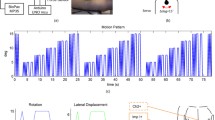Abstract
Potential and impedance variations were studied with varying mechanical stress upon the skin. The size of the potential variations in the skin and the mechanical stress possess a nonlinear relationship which varies between individuals. The impedance variations did not bring about the potential variations. The time sequences for impedance and potential variations do not have the same form when the skin is stressed as when it is relaxed. The rapid initial potential variation upon stressing had a calculated rise time of 30 ms. The rise time during relaxation was 40s. The difference in rise time gives the relationship between potential and deformation a nonlinear character.
Similar content being viewed by others
References
Almasi J. J. andSchmitt, O. H. (1974) Automated measurement of bioelectric impedance at very low frequencies.Computers & Bio. Res.,7, 449–456.
Barbenel, J. C., Evans, J. H. andFinlay, J. B. (1973) Stress-strain-time relations for soft connective tissues. InKenedi, R. M. (ed.)Perspectives in biomedical engineering, MacMillan Press Ltd., New York, 165–172.
Bickford, R. G. (1974) Quantitative techniques in ECG. InRay, C. D. (Ed.),Medical Engineering, Year Book Medical Publishers, Chicago, 385–404.
Burbank, D. P. andWebster, J. G. (1978) Reducing skin potential motion artefact by skin abrasion.Med. & Biol. Eng. & Comput.,16, 31–38.
Crisp, J. D. C. (1972) Properties of tendon and skin. InFung, Y. C., Peronne, N. andAnliken, M. (eds.)Biomechanics: Its foundations and objectives, Prentice-Hall Inc, New York, 141–180.
Ebbecke, U. (1921) Die Lokale galvanische Reaktion der Haut.Arch. Ges. Physiol. 190, 230–269.
Edelberg R. (1973) Local electrical response of the skin to deformation.J. Appl. Physiol.,34, 334–340.
Gunner, C. W., Hutton, W. C. andBurlin, T. E. (1979) Technical note: an apparatus for measuring recoil characteristics of human skinin vivo.Med. & Biol. Eng. & Comput.,17, 142–144.
Rein, H. (1929) Die Elektrophysiologie der Haut. InJadassohn, J. (ed.)Handbuch der Haut und Geschlechtskrankheiten, Springer, Berlin, 43–91.
Shackel, B. (1959) Skin drilling: a method of diminishing galvanic skin potentials.Amer. J. Psych.,72, 114–121.
Tam, H. W. andWebster, J. G. (1977) Minimizing electrode motion artifact by skin abrasion.IEEE Trans.,ME-24, 134–139.
Thakor, N. V. andWebster, J. G. (1978) The origin of skin potential and its variation. 31st ACEMB, Marriot Hotel, Atlanta, Georgia, 24–25th October.
Wolf, H. K., Macinnis, P. J., Stock, S., Heippi R. K. andRautaharju, P. M. (1972) Computer analysis of rest and exercise electrocardiograms.Comput. & Biomed. Res. 5, 329–346.
Author information
Authors and Affiliations
Rights and permissions
About this article
Cite this article
Ödman, S. Potential and impedance variations following skin deformation. Med. Biol. Eng. Comput. 19, 271–278 (1981). https://doi.org/10.1007/BF02442544
Received:
Revised:
Issue Date:
DOI: https://doi.org/10.1007/BF02442544




